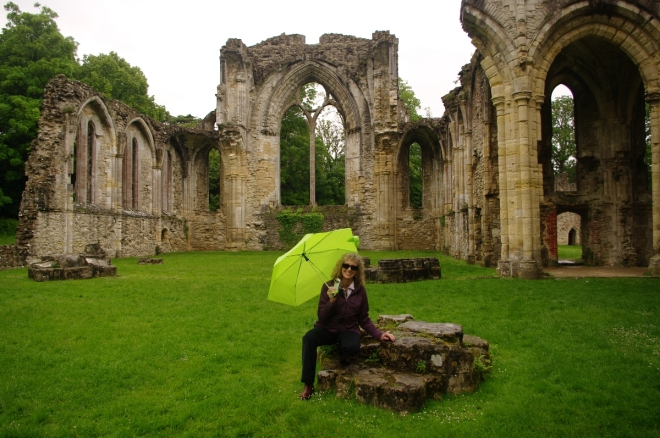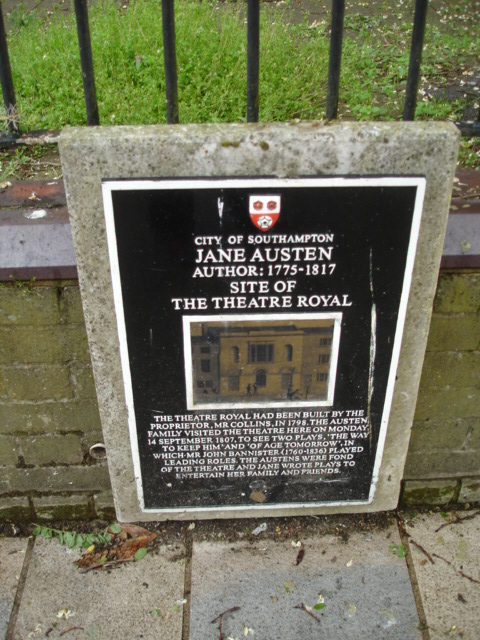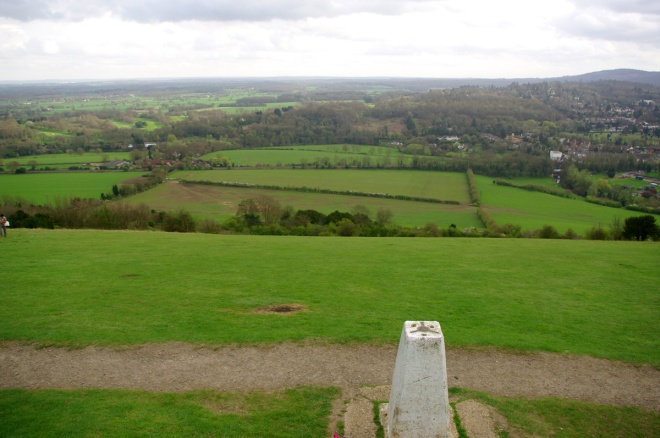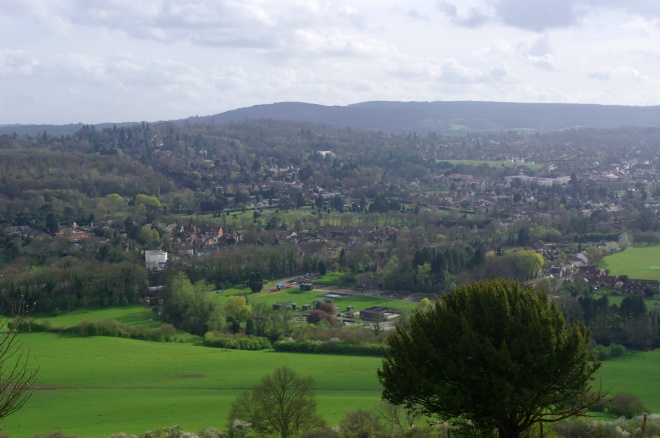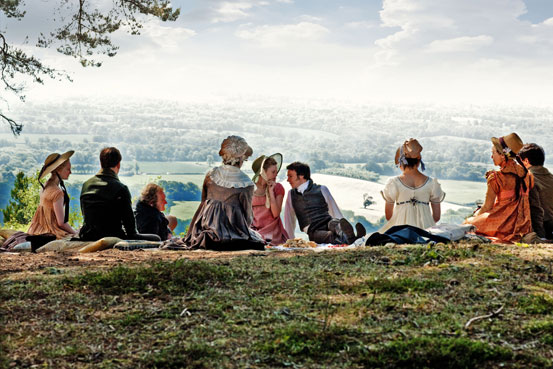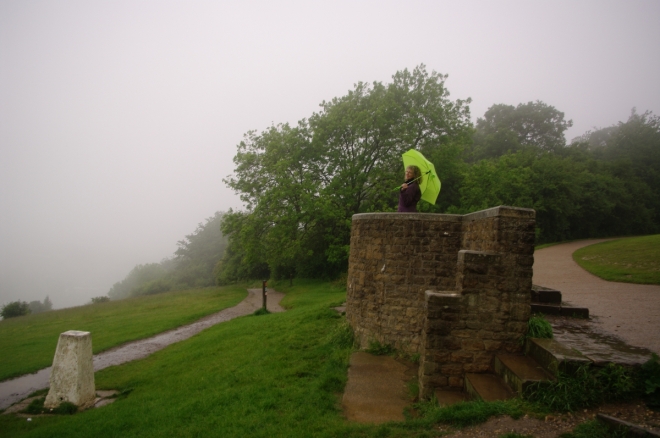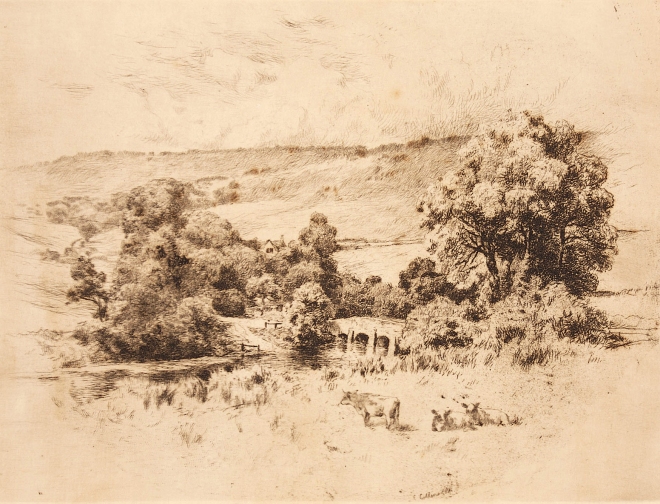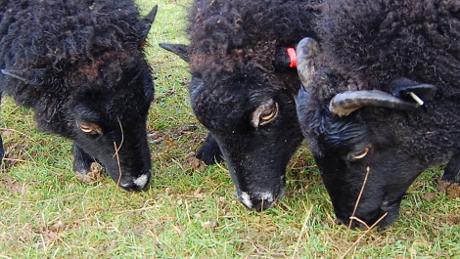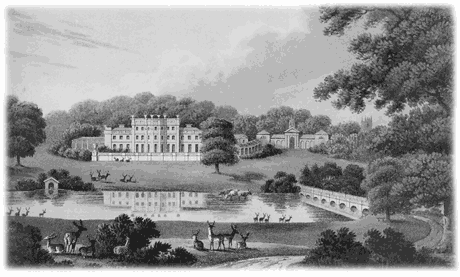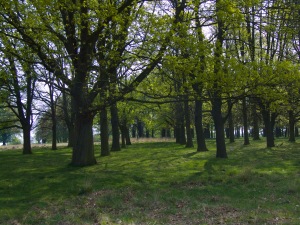Gentle Readers: The post last week on Hazel Jones’ book The Other Knight Boys brought up the issue of cricket (in a comment from Lisa Brown) – did Austen’s nephews play it? And from there, we all got cricket-happy. Thankfully Tony Grant, a cricket player in his own right, offered to tell us a little about the game that most Americans haven’t a clue about – along with his own reminiscences of a particular game he played in the Summer of 1973. (sounds like a movie)… so a hearty welcome to Tony, with thanks!
*********
CRICKET, JANE AUSTEN AND ME
By Tony Grant

History of Cricket at Game Connor
When I was seven years old my father bought me a cricket bat. He also bought this book for me, Approach to the Game: CRICKET_HOW TO PLAY, published for the M.C.C [Marylebone Cricket Club] 1955. It had some clear illustrations in it so I could analyse how to play certain skills.
I can remember my father teaching me how to hold a bat, how to form a balanced stance at the crease, how to hold my head level with my eyes looking straight ahead and how to make a forward defensive stroke. Using a tennis ball pitched up to me I soon learned how to watch a ball and time a stroke perfectly while remaining in a balanced pose keeping my head over the bat and ball to keep the ball down on the ground, eventually learning to follow through with a straight bat and so performing a forward drive. I was so enthused I used to practice all these different elements of batting again and again, sometimes with a bat and sometimes just with a stick. I practiced batting strokes until they became automatic.
Cricket is a hard task master: it demands common-sense, imagination, concentration and character,……
but there is something that matters even more than making runs or taking wickets or being a good fielder.
A cricketer should never forget that they are playing with, as well as against the other team and that they are either their host or their guest.
They should strive for all that it is worth to win or, if they cannot win to avert defeat: but there is a price beyond which victory or the avoidance of defeat should never be bought.
For in cricket, however hard it is played- and if it is worth playing at all, it is worth playing hard- the struggle and its result should never obscure the true ends for which it is played, recreation, good fellowship, the training of character. And above all the conviction which the game that can bring with it, that through it and what it gives, life is indeed the more worth living.
H.S. Altham
Chairman MCC Youth Cricket Association
I sometimes wonder why sport is so important. Why are humans so addicted to it? Why is it so enthralling and exciting to see runs made and your team win and why it can be so heart-breaking when you lose? It is all the things mentioned in the above statement but I think it is more than that. It is art and history, philosophy and psychology, courage, self-analysis, creativity and it makes us plan and adapt. It is emotional, bringing joy and pain. We have to plan, predict and adapt. A sport is not meaningless, it enables us to practice every human trait and it brings good company and friendship.
History of the Game:
A game similar to cricket is recorded as long ago as the 12th century. However, cricket closer to the game we know today was founded at Hambledon Cricket Club in Hampshire in 1750 when many of the laws for cricket were first developed. In 1787 the Marylebone Cricket Club in St Johns Wood near Regents Park in London, was set up. An ad hoc formation of clubs had been happening all over the country independent of each before Hambledon Cricket Club was formed and before the MCC created a unified code for the game. Marylebone Cricket Club is now regarded as the home of English Cricket and cricket worldwide. The ground is called Lords Cricket Ground, named after Thomas Lord who purchased the site and started the Marylebone club. It is commonly called the M.C.C.
Jane Austen and cricket:
In the first chapter of Northanger Abbey, Jane Austen introduces the reader to Catherine Moreland.
She was fond of all boys’ plays, and greatly preferred cricket not merely to dolls, but to the more heroic enjoyments of infancy, nursing a dormouse, feeding a canary-bird or watering a rose bush.
Andrew Davies in the recent televised series Sanditon has Charlotte Heywood batting in a cricket match on Sanditon beach and making the winning runs. [fabulous scene!]
We can imagine that Jane Austen with, six brothers, joined enthusiastically too in the “boys’ plays.” Perhaps Jane played cricket?
The Jane Austen Society (UK) has very kindly made their reports free for everybody to gain access to. In the Collected Reports, 2001 – 2005 an article by Margaret Wilson is entitled “The Austens, the Knights and Cricket in Kent.” [link]
The Austen family in Kent were players, spectators and administrators of the game. Jane’s brother Francis had a grandson who played in the Charterhouse School cricket team. Thomas Austen gave ten shillings to help finance the purchase of The Vine Ground in Seven Oaks for the playing of cricket. Fanny Knight, Jane’s favourite niece, wrote about her brothers as being “rather mad about cricket.” Edward Austen Knight’s eldest son, also called Edward, played for Kent in 1822 and for Hampshire between 1827 and 1828. The nephews Edward and George played for Chawton Village in May 1820, although Chawton Village Cricket Club itself was not established until 1883.
George Knight especially made his mark on the game of cricket. Jane called him “itty Dordy.” He played for Kent and Hampshire but he helped develop the game of cricket by being a proponent of round arm bowling during the 1820s. This was a revolution in cricket at the time. A smooth under arm bowling action had always been the rule. Over or round arm bowling added extra speed and variety to the bowling technique. Batters had to become more proficient and develop skills to counter this development. Round arm bowling therefore made a big leap in cricket’s development and George was an instigator in how we play the game today. George also wrote about cricket in letters to The Sporting Magazine in 1827. Jane’s nephew, Brook John Knight, played for Kent in1844. Her great nephew Wyndham, the son of the younger Edward Knight, played for a Kent XI in 1862. Apparently he was a good fielder. Fanny Knights husband Sir Edward Knatchbull also had many cricketers in his family.
**********
 WISDEN is the cricketer’s almanac that has been published since 1864. This year it is 156 years old and there have been 155 editions. The cricket season is not over for this year.
WISDEN is the cricketer’s almanac that has been published since 1864. This year it is 156 years old and there have been 155 editions. The cricket season is not over for this year.
Each edition of Wisden comprises 1300 pages of small tightly packed print. It includes everything anybody would want to know about cricket. Each WISDEN particularly focuses on the previous seasons matches. There are articles about players and clubs in the past; there are biographies of famous players past and present. Reports give detailed accounts about today’s cricketing stars and their performances over their career. There are extensive reports about every test match England has played in the previous season along with all the statistics of runs, wickets taken and the performances of each player who played in the match. Chapters cover each of the County teams, such as Hampshire, Surrey, Worcestershire, Somerset, Nottinghamshire and so forth, providing detailed reports of every match the county teams played and their statistics, runs, wickets, and overs for each match. WISDEN is very entertaining to read providing vivid and descriptive reports and biographies. The writing is amongst the best in sports journalism.
Here are two pages to provide you with a flavour of this annual almanac.A report on the Hampshire v Nottinghamshire match, played between May 31 and the 2nd and 3rd of June 1986 with a report and the statistics. Also I have included the opening part of a biographical piece on the great England and Surrey player Jim Laker. I met Jim Laker once when he came to visit Thames Ditton Cricket Club on Giggs Hill green near Surbiton. It was the Thames Ditton Cricket clubs 100th anniversary and he was invited to our celebrations. He readily helped me do some coaching with the colts before the senior game commenced. I was not only a player at the club at the time but the youth team coach and manager. He offered to umpire in the main match of the day. He was a lovely warm character and we were all in awe of him. In 1956 Jim Laker not only took 10 Australian wickets when Australia played Surrey at the Oval he also decimated the Australians at Old Trafford Test match bowing 19 wickets in the two innings. He has been regarded as the best England bowler ever. He was a right arm off break bowler.
A Game of Cricket, Summer of 1973
The Summer of 1973, I was 20 years old and I was working for Southampton Magistrates Courts at the Civic Centre as a clerical assistant. The city council employees organised various social clubs including a cricket team. I was a member of the cricket team.
It was just before my 21st birthday, Midsummers Day had passed and we were enjoying a heatwave in Southern England. The cricket team had their next fixture away, on Saturday 23rd June against the Longparish second eleven. Longparish is a beautiful Hampshire village west of Basingstoke, not far from the villages of Steventon, Deane and Ash, where Jane Austen lived. The cricket club at Longparish was founded in 1878. On the team list I was down to bat at number four and I was also to bowl third after the two opening fast bowlers needed to rest.
We fielded first and Chris Long, our captain asked me to field at first slip close in on the batsman facing the bowling. The sun shone down out of a blue sky and I could feel the heat on my back. Luckily the sun was behind the slips so it wasn’t in our eyes. I crouched low, just behind the line of view of the opening batsman. I held my hands cupped stretched out in front of me, my eyes focussed intently on the blade of his bat. Slip fielding needs an intense concentration. Your reactions have to be lightning fast. You have only a split second to react. John Heath our opening bowler ran in on a long curving approach line up to the wicket and sent down a fast lightening ball that I heard thud into the ground in front of the batsman sending up a puff of dust followed by a sharp crack as the batsman met the ball on the rise in the middle of his bat with a forward defensive stroke. For the next six balls the batsman played the same stroke to the same line of bowling. Each time the two other slips and I relieved these moments of intense concentration by standing straight, loosening our arms and legs by stretching and bouncing loosely on the spot. The batsman was trying to tire out John with his furious over arm action sending down bullet fast balls. The batsman was beginning to look confident already. John would need to change his tactics. He decided to bowl round the wicket instead of over the wicket. This enabled him to send in his fast bowls at a different angle. The batsman looked nervous. He moved his feet to get his left foot near the pitch of the ball as it once more zipped into the dusty ground in front of him. He had timed his stroke nearly perfectly but not quite. I heard the sharp snap of an edge. I reacted leaping to my right. The ball was coming very fast. I got my right hand to it in an instinctive reflex reaction. My hand got to the ball but I couldn’t hold it. I parried it to the ground. The batsman thought he had beaten me and the other slips. But my fielding colleague next to me picked up the blocked ball and in one clean under arm action whipped the bails off and with a roar we all leapt into the air. The batsman out of his crease was stumped and he made his lonely walk back to the pavilion with a duck to his name. What a start we had. The palm of my hand smarted and throbbed but I was elated. I had stopped a rocket of a ball. The batsman had really put his shoulders and arms into his stroke.
Later on in the first innings I was called on to bowl. I am a medium paced bowler because of my height. I have, however, managed to develop some tricks to fool and confuse any batsman. To warm up in my first over I kept the ball steady, even paced and straight. I placed the ball each time on the same spot, just forward of the batsman’s off side so he had to step out to the ball and strike it on the off. I arranged the fielders so that they could block any balls coming in that direction. The first few balls the batsman managed to drive to the off but they carried straight to the fielders who quickly gathered the ball each time and threw it accurately and straight to the wicket keeper. The batsman managed two runs in my first over. By now my arms and shoulders had loosened up. I thought I would try and fool the batsman with some pace. My run up and action looked the same as before but this time I opened my shoulders wider, and brought my right arm over from behind me, hidden at first from the batsman’s view. This time I had relaxed my bowling wrist at a cocked angle. As I brought my arm over I flicked my wrist into action at the point of delivery giving the ball a much faster pace and I thumped it down slightly more in front of the batsman in line with the wickets. He had to adjust his stance to counteract the more full on ball coming at a faster pace. He struggled to parry it down with a backward defensive stroke. That brought a smile to my face. The next ball I changed tactics again. I vigorously polished one side of the ball on the leg of my cricket whites, as I walked back to the start of my run up. This caused a red stain on my trousers. Polishing one side of a red leather cricket ball until it shines and holding the ball slightly off centre of the seam creates a swing effect. The air moves faster over the polished surface making that side move faster in the air. With the polished side on the off side I manged to create an in-swinging ball and with the extra flick of my wrist I sent it down at a pace, the ball moving into the batsman’s body. He edged it fast towards short leg on his leg side flailing hands and some acrobatics from the fielder positioned there but the ball rushed on to the boundary for four. A gasp went up because he had so nearly been caught. I had got him worried. I kept up a barrage of accurately placed balls hitting the same spot on the wicket causing the earth to become rough and pitted. He didn’t score anymore in that over. When the bowling changed ends the batsmen conversed in the middle of the wicket together. In my next over I was facing the other batsman. I was feeling good and decided to shake him up a little. I zipped in a ball angled from over the wicket and he edged it to the slips one of whom parried it to the ground but didn’t catch it. I tried another ball over the wicket, zipping it apparently straight at his legs but this time making the ball outswing. The ball took him off guard. It arrowed through his defence between bat and pad and carried to the wicket keepers gloves who with a sudden flurry took off the bails and yelled ”Howzat!!” The umpire unmoved for a moment looked, thought and then raised his finger. We all cheered and ran to the middle of the wicket to congratulate each other. Another wicket taken. The batsman had come out of his crease to attempt a stroke at my delivery and didn’t have time to retreat. The game was going our way.
Later I went into bat at number four during our innings. We had fifty runs on the board. They had scored 234 runs, so we had some ground to make up.
I stood in front of the wicket and made a mark on the ground with the end of my bat showing me the centre of the crease. This was so I could adjust my stance depending on the angle the bowler was bowling in from. I had watched him for a few overs previously and had a good idea of his pace and how he angled in the balls and where he was likely to pitch the ball. I had it in mind to parry the first few balls with forward defensive strokes until I got my eye in. I noticed some people moving near the boundary and asked the umpire to move them out of the way. I also asked for the sight screen to be moved more to the left in line with where I knew the bowler would approach on his run in. I could see the bowler’s action better highlighted against the white screen. I tried to be as relaxed as possible standing, my feet parallel to each other and slightly apart, side on to the bowler in a slightly crouching pose with my head up. My eyes looked forward, steadily at the bowler. I held the bat angled directly behind me, my left hand gripping the top part of the handle, my left arm and elbow pointing forward ready to make the stroke, my right hand gripping the lower part of the bat handle ready to guide the bat. Everything was in line. Timing is all. As the bowler ran in I concentrated on his arm. As he rose up into his action at the opposite crease my right arm lifted the bat up directly behind me, my face and body leaning into a forward pose ready for action. My eyes fixed on his bowling action and within a split second of the ball leaving the bowlers hand I moved my feet swiftly forward, my left foot placed down next to the pitch of the ball as it bit into the ground surface in front of me, my body straining forward , my head and eyes over the top of the pitching ball to keep the resultant contact on the ball down, my arms following through swinging the bat in a straight fluid smooth arc my head and body in balance, my arms following through. The sound of a sharp crack, ball on bat, and the ball was speeding across the grassy surface towards the fielder at mid-off. All this happened at once. It’s all about position, timing and a skillful execution of the batting stroke.
I was very pleased to be able to execute my favourite swash-buckling stroke, a square cut off the back foot. The bowler I was facing was getting tired and he was beginning to make mistakes. One delivery came down pitched short on my off side and rose up high. I took a step back with my bat parallel with my shoulders, my eyes firmly on the rising ball and swiftly swung the bat in a graceful arc around my body from right to left hitting the ball at the top of its bounce and smashed it through the covers speeding along the ground for four runs. Balls like that are a gift. However, some technique is required. If you top edge it you will be caught out and if you try and send it for a six, if you have not the strength and power it will not reach the boundary before landing and you could again be caught. The skill is to roll your wrists. As you swing the bat into the line of the ball, roll both wrists over the top of the handle as you contact the ball. This will have the effect of playing the ball down at an angle so it will quickly reach the ground and travel at speed along the surface. If it is fielded by one of the opposing players there is no problem, the ball is on the ground. Performed properly it should speed to the boundary for four. During the game I scored a presentable twenty-seven runs before being caught attempting to hit a six to the boundary. I got lazy.
In the club house at Longparish, I remember we had a lovely tea with a selection of sandwiches, brown wholemeal bread with ham, cheese and egg fillings, made by members of the Longparish Cricket Club. Mugs of hot tea were drunk. The bar was opened so some of our team had a pint. The proverbial icing on the cake was that we won the game but only by 15 runs. A close fought match but extremely enjoyable.
References:
N. S. Creek. Teach Yourself Cricket. English Universities Press, 1964.
Play The Game Series. Cricket:How To Play. Published for the MCC Educational Productions, 1955.
Margaret Wilson. “The Austens, The Knights and Cricket in Kent.” Jane Austen Society Collected Reports 2001-2005. 139-41.
Michael Davis. “Jane Austen and Cricket.” Jane Austen Society Collected Reports 1996-2000. 307-311.
WISDEN (124th year) Cricketers Almanac 1987. Ed. Graeme Wright. John Wisden & Co, 1987.
Links to cricket clubs:
- Longparish Cricket Club: https://longparishcc.hitscricket.com/
- Thames Ditton Cricket Club: https://www.thamesdittoncricketclub.co.uk/
- East Molesey Cricket Club: https://www.eastmoleseycc.com/
- Chawton Cricket Club: http://chawtonparishcouncil.org/village/chawton-cricket-club/
- Hambledon Cricket Club: https://www.hambledoncricketclub.co.uk/
- MCC (Marylebone Cricket Club): https://www.lords.org/
********
Thank you Tony for bringing this game so to life for us, and for sharing all your knowledge about cricket! I did find this for my Gentle Readers, in case like me, you are still completely confused! How to Play Cricket, A Beginner’s Guide! and details on the Laws of cricket at wikipedia here.
And here’s one for The Ladies! (along with Charlotte Heywood)
Cricket Match Played by the Countess of Derby and Other Ladies, 1779 –
Marylebone Cricket Club Collection – public domain – wikipedia



















